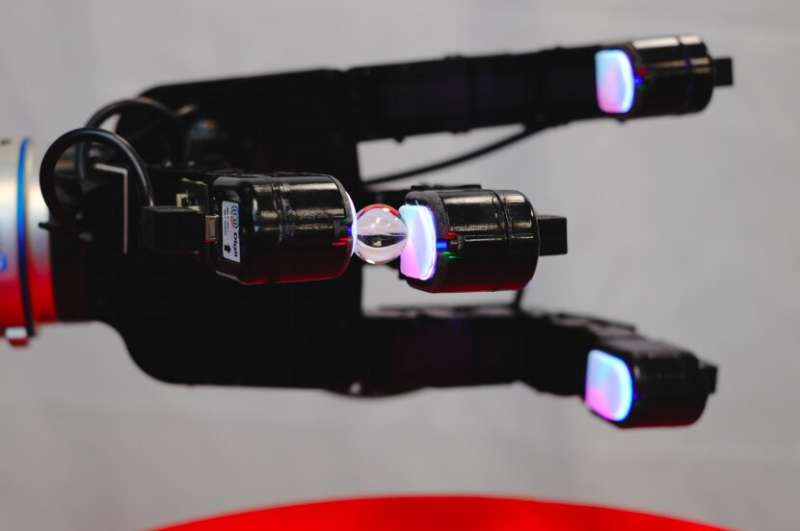DIGIT sensors mounted on an Allegro multi-fingered hand. Credit: Lambeta et al.
To assist humans in completing manual chores or tasks, robots must efficiently grasp and manipulate objects in their surroundings. While in recent years robotics researchers have developed a growing number of techniques that allow robots to pick up and handle objects, most of these only proved to be effective when tackling very basic tasks, such as picking up an object or moving it from one place to another.
High-resolution sensors could enable more advanced robot manipulation capabilities by gathering valuable tactile information that can be used to identify the best strategies for manipulating specific objects. Many existing tactile sensors are highly efficient but expensive to produce, which makes them difficult or impossible to implement on a large-scale; others are inexpensive but with a limited resolution and performance.
With this in mind, researchers at Facebook recently designed DIGIT, a tactile sensor that is compact, affordable, and can also collect high-resolution images. DIGIT, presented in a paper pre-published on arXiv, could facilitate the development of robots capable of completing a greater variety of tasks involving in-hand manipulation.
"One of the contributing factors that limit current robotic manipulation systems is the difficulty in precisely sensing contact forces," the researchers wrote in their paper. "Sensing and reasoning about contact forces are crucial to accurately control interactions with the environment. As a step toward enabling better robotic manipulation we introduce DIGIT, an inexpensive, compact and high-resolution tactile sensor geared towards in-hand manipulation."
The sensor developed by this team of researchers at Facebook draws inspiration from sensing technologies developed in the past. However, the new sensor is miniaturized, and can thus be mounted on robotic hands with multiple fingers.
DIGIT is characterized by a unique, fairly straightforward design, which makes it easier to manufacture over shorter periods of time and on a larger scale. As a result, the sensor is more affordable than other solutions capable of capturing images with comparable resolutions.
To evaluate DIGIT's performance, the researchers applied one sensor to each of the fingers on an Allegro hand, a multi-finger robotic hand developed by Simlab that is often used to test computational techniques for object manipulation. In their experiments, they trained a deep neural-network-based model to act as a controller for the Allegro hand, allowing it to manipulate glass marbles. This model was trained using data collected by the DIGIT sensors.
In these tests, the sensor performed remarkably well, gathering high-resolution tactile data that could be used to train deep neural networks to guide the Allegro hand toward desired positions during the marble manipulation task. In their future work, the researchers plan to continue working on their sensor, further miniaturizing its form factor and enabling curved, omni-directional sensing fields.
Meanwhile, DIGIT sensors could be integrated and tested on a variety of humanoid robots, potentially enhancing their in-hand manipulation capabilities. Other research and development teams interested in fabricating the sensors or adapting them to their needs can access the researchers' design for free at www.digit.ml.
More information: DIGIT: A novel design for a low-cost compact high-resolution tactile sensor with application to in-hand manipulation. arXiv:2005.14679 [cs.RO]. arxiv.org/abs/2005.14679
© 2020 Science X Network
























